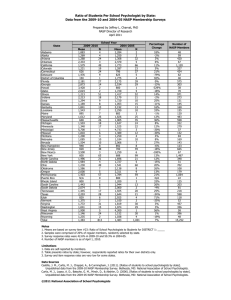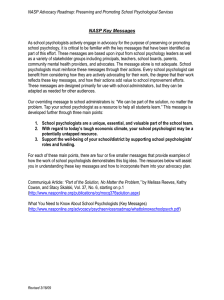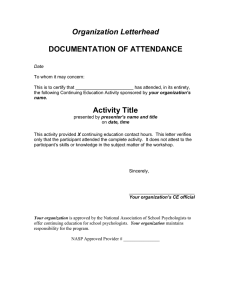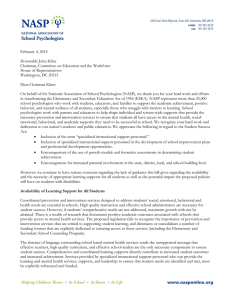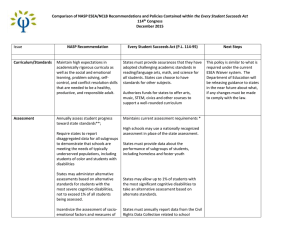Ready to Learn, Empowered to Teach Guiding Principles for Effective Education
advertisement
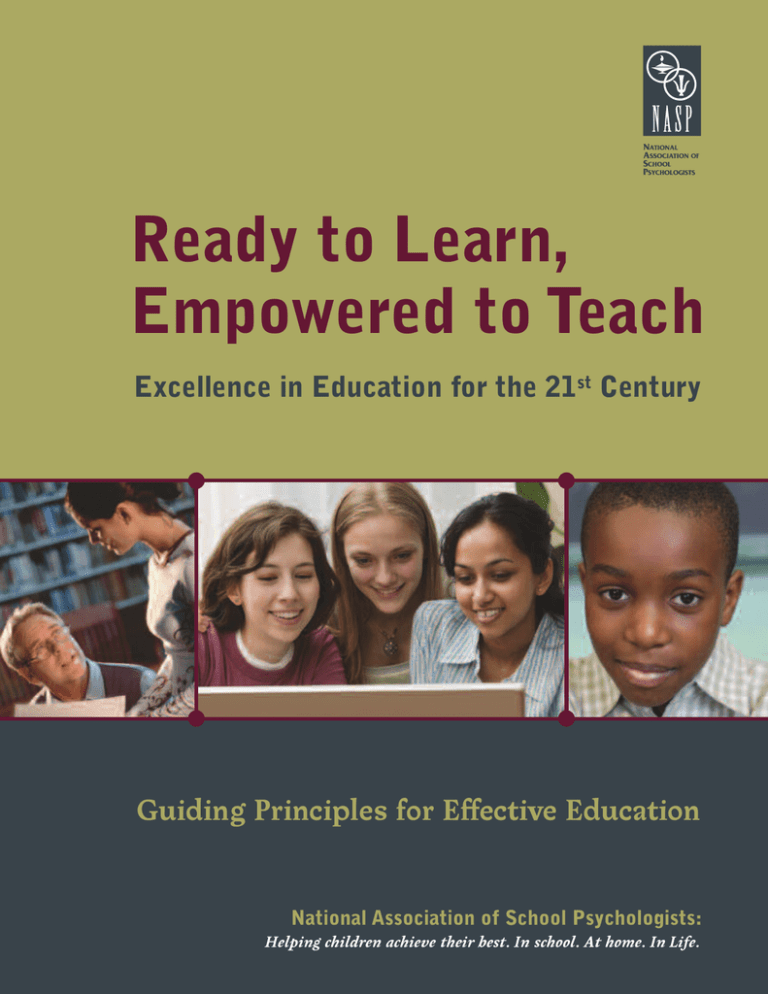
Ready to Learn, Empowered to Teach Excellence in Education for the 21st Century Guiding Principles for Effective Education National Association of School Psychologists: Helping children achieve their best. In school. At home. In Life. Ready to Learn, Empowered to Teach Excellence in Education for the 21st Century National Association of School Psychologists’ Guiding Principles for Effective Education The National Association of School Psychologists (NASP) believes that accessible, high quality education forms the foundation of our collective commitment to safeguard our children today and prepare them to meet the challenges of tomorrow. It is the most important investment we can make in our nation’s future, and NASP urges the next President of the United States to make education that meets the needs of the whole child a priority. NASP represents over 25,000 school psychologists who work with students, educators, and families to support the academic achievement, positive behavior, and mental wellness of all students, especially those who struggle with barriers to learning. Achieving excellence in education for the 21st Century requires that every student is ready to learn and every teacher is empowered to teach. From pre-kindergarten through high school graduation, children need to be healthy, supported, and focused when they come to school. All children possess tremendous potential and deserve access to comprehensive, rigorous curricula and high quality instruction. Too often, though, they come to class struggling with life challenges that can create barriers to learning—and teaching—as well as undermine school climate. Left unaddressed, issues such as learning difficulties, poor mental and physical health, cultural and linguistic differences, and socioeconomic or family problems can significantly impede student and school success. Even the most highly skilled teachers cannot help children achieve 1 their fullest potential unless such barriers to learning and instruction are remedied. Teachers cannot do this alone and it is counterproductive to expect them to. The educational environment presents unique opportunities to address barriers, but only when services are available that support the whole child. Effective student support services enable teachers, administrators, and parents to know how best to ensure that students are ready and able to learn. They also guide progress monitoring and accountability measures that inform better instruction and provide a comprehensive picture Services that lower of student and school barriers to learning are achievement. not ancillary to education but rather central to the supportive educational process necessary to prepare all of America’s children for academic success, healthy development, and responsible citizenship. While many factors contribute to effective education, such as school infrastructure, technology, and professional advancement opportunities for educators, this document recommends action designed to lower or remove barriers to learning by addressing instruction, behavior, and mental health. NASP firmly believes that the issues involved are not ancillary to education but rather central to the supportive edu- READY TO LEARN, EMPOWERED TO TEACH cational process necessary to prepare all of America’s children for academic success, healthy development, and responsible citizenship. GUIDING PRINCIPLES We encourage the President of the United States to work with Congress to incorporate the following guiding principles in the development of educational policies: 1. Combine high expectations for achievement with appropriate individualized instruction across curricula that reflect the knowledge and skills required to succeed in the 21st Century and that provide truly equal educational opportunities for all students. Key Policy Objectives: • • • • • Maintain high expectations and provide academic rigor across the spectrum of academic and life skills curricula. Ensure access to high quality instruction that meets the individual learning needs of all students. Ensure that instruction, assessment, and interventions are responsive to students’ individual backgrounds and circumstances, including culture and language. Monitor individual student progress frequently and over time to ensure learning and to make decisions about appropriate interventions. Align and ensure the consistency of related principles in IDEA and ESEA/NCLB. Research demonstrates that high expectations correlate with high achievement (Jussim, Smith, Madon, & Palumbo, 1998; Weinstein, 2002).This holds true across the spectrum of academic and life skills necessary to becoming a healthy, productive, and responsible adult. A commitment to high expectations must extend beyond math and reading to include the sciences and social sciences, foreign languages, fine arts, physical and mental health, and work readiness skills. A comprehensive 21st Century education also teaches students social– emotional competency, self-control, problem-solving and conflict resolution skills, the ability to access and evaluate the READY TO LEARN, EMPOWERED TO TEACH validity of information, and the ability to thrive in an increasingly competitive global economy. Providing rich content and academic rigor alone is not enough. These must be matched with instruction that meets students’ learning needs to ensure that they have the genuine opportunity to achieve their full potential. Educators need access to the wide body of knowledge available on how to make content more readily accessible to students, using research-based needs assessments, individualized instruction, and formative evaluations of progress to confirm that students are learning. Ongoing progress monitoring, such as that used in response-to-intervention models, can be used effectively to assess individual student performance gains and to inform instruction and intervention. It is critical that highly qualified instructional support personnel be available and responsive to individual student needs and development, including cultural and linguistic backgrounds, family circumstances, and behavioral and mental health needs. The trend of mislabeling minority children as needing special education because of flawed assessments that fail to take student language and backgrounds into account not only limits children’s potential, but also strains the special education system. Only trained professionals can differentiate between a disability that requires special education and difficulties that can be addressed with targeted interventions and support in the regular classroom. In this regard, schools and children will benefit if terminology and policies in IDEA and ESEA/NCLB are aligned to improve continuity across general and special education and to streamline processes, reporting, and funding. Providing rich content and academic rigor is critical but alone is not enough. These must be matched with instruction that meets students’ learning needs to ensure that they have the genuine opportunity to achieve their full potential. 2. Provide sufficient student support services to meet the needs of the whole child in order to promote healthy learning and development. Key Policy Objectives: • Ensure access for all children to support services to address the spectrum of barriers caused by health, 2 • • • • behavioral, psychological, and environmental problems that can prevent students from being ready and able to learn. Provide appropriately trained professionals to help lower barriers to learning and to provide support needed by teachers. Promote research-based alternatives to grade retention and social promotion. Extend supports to include high quality early childhood and after-school programming for at-risk children and youth. Coordinate services across a continuum of care that integrates schools, families, and community providers. Students must be physically, socially, emotionally, and behaviorally ready and able to learn in order to succeed in school. Unfortunately, many struggle with barriers that impede learning and teaching. Relevant research indicates that family risk factors are associated with poor performance in school-aged children and are also linked with lower proficiency in early reading, math skills, and general knowledge (U.S. Department of Education, National Center for Education Statistics, 2000). One in five children and adolescents will experience a significant mental health problem that can interfere with their educational achievement during their school years (U.S. Department of Health and Human Services, 1999). Also, teachers cite student behavior and attitude, lack of student motivation, poor school climate, and lack of adequate support among the top reasons for leaving the profession (Ingersoll, 2001). Despite these challenges, we know that there are proven strategies to address such barriers in ways that are appropriate to and supportive of the mission and purpose of schools. Access to student supports is cost–effective; directly assists teachers, administrators, and families; and Access to student supports improves school outis cost–effective; directly comes. For example, assists teachers, longitudinal studies administrators, and provide strong empirical families; and improves evidence that interventions that strengthen school outcomes. students’ social, emotional, and decision-making skills also positively impact their academic achievement, in terms of both higher standardized test scores and better grades (e.g., Fleming, Haggerty, Brown, Catalano, et al., 2005). Effective student supports include 3 mental health services, emphasize prevention and early intervention, actively engage families, and incorporate strengthbased approaches such as positive behavioral supports, social–emotional learning, and response to Addressing problems intervention. Addressing before they escalate or problems before they become chronic is less escalate or become costly over time than chronic is less costly over time than intensive intensive remedial remedial services or negservices or negative ative outcomes such as outcomes such as dropping out of school, dropping out of school, delinquency, or incarcerdelinquency, or ation (Aos, Lieb, Mayfield, Miller, & Pennucci, incarceration. 2004; National Research Council and Institute of Medicine, 2000). For at-risk children and youth, in particular, services should begin in early childhood and include quality after-school activities at all ages to ensure better outcomes. Families are children’s first and most important source of guidance and care and they are essential partners in the learning process. Providing supports within a continuum of care that engages families, educators, and community service providers promotes continuity and enhances effectiveness. School-employed professionals who are trained specifically for work in educational settings are best equipped to guide school-based services, even those provided in schools by community providers. Professionals like school psychologists, counselors, social workers, and nurses are specially trained in school law, learning, child development, and how school systems function, as well as in family systems, traditions and cultures, and mental health service delivery. This expertise is especially important in school districts serving high need populations if we are to genuinely raise the bar and close the gap in achievement for all students. 3. Expand accountability systems to reflect a comprehensive picture of students’ and schools’ performance rather than relying primarily on high-stakes testing. Key Policy Objectives: • Broaden accountability measures to include multiple indicators of student achievement, including those READY TO LEARN, EMPOWERED TO TEACH • • • • related to behavior, physical and mental health, and wellness. Ensure that measures are adapted to be valid and reliable for all student subpopulations. Use ongoing accountability measures to inform instruction, intervention, and school-wide improvement efforts. Include rates and effectiveness of home–school– community collaboration as part of school accountability measures. Base high-stakes decisions only on the use of multiple methods of data collection that have been validated for the intended purposes. As stewards of our most important national resource, schools need to be accountable to the public, and especially to families, regarding the quality of instruction and other services they provide. However, schools are not one-dimensional in either their purpose or functioning, and neither Schools are not oneshould be outcome dimensional in either measures. Student pertheir purpose or formance assessments functioning, and neither and school accountabilshould be outcome ity systems must move from an overwhelming measures. reliance on standardized tests of student achievement to the use of multiple indicators of student outcomes that also monitor progress toward life goals along with health, behavior, and well-being. Outcomes should be measured by assessing growth over time and using systems that are valid and reliable for subpopulations, including those representing culturally and linguistically diverse groups, development across different ages, geographic regions, and school communities. As with individual student progress monitoring, systemic school improvement efforts should look at academic factors related to school success and those that contribute to positive learning environments, including connectedness, school safety, and the supports needed by struggling learners. Including measures of parent involvement and community collaboration—both of which markedly contribute to achievement—provides a clearer picture of overall school functioning. Use of comprehensive data in decision-making allows school leaders to channel resources into the most costeffective and sustainable approaches to bolster student success in ways that are most appropriate for their school community. READY TO LEARN, EMPOWERED TO TEACH 4. Build the capacity for instructional excellence that empowers teachers to teach creatively and effectively. Key Policy Objectives: • • • • Create smaller classrooms and improved student– staff ratios based upon research data, which specify how these are directly linked to meeting the needs of and improving outcomes for all students. Provide professional support personnel to help lower barriers to learning and teaching. Invest in rigorous, career-long training that includes opportunities for all educators to receive continuing professional development across a spectrum of learning objectives and areas of professional functioning. Promote strong, supportive school leadership and opportunities for peer-to-peer consultation, problem solving, assessment, and intervention. Every child deserves access to high quality instruction from teachers who are able to address his or her individual learning needs. Instructional excellence depends on rigorous and career-long training, adequate student–staff ratios, access to student resources and supports, effective leadership, and opportunities for collaborative problem-solving. Equally important, a school’s commitment must extend beyond teachers to other key school personnel who are essential to student achievement and positive behavioral outcomes. Teachers cannot be held solely accountable for all students’ learning. It is imperative to make a national commitment to top-notch educator quality, training, and performance Commitment to through investments in professional excellence comprehensive training must extend beyond standards, meaningful teachers to other key field-based experiences school personnel who are with opportunities for critical performance essential to student feedback, on the job achievement and positive coaching and mentoring, behavioral outcomes. and needs-based staff development opportunities. Professional development needs to include classroombased strategies for ongoing progress monitoring and response-to-intervention methods; prevention of school failure; and specific academic, social–emotional, and behavioral 4 strategies for struggling students. The foundational skills of effective educators are built during their initial training programs and galvanized over time through career-long mentoring and professional development experiences. Such skills need to be reinforced through leadership support, colleague mentoring, and opportunities for collaborative teamwork that facilitates problem-solving and peer-to-peer learning. 5. Provide federal leadership that facilitates evidence-based practice and wellcoordinated, fully funded federal policies. Key Policy Objectives: • • • • Fully fund educational mandates such as IDEA and ESEA/NCLB. Strengthen emphasis on school-based research to identify evidence-based practices that are effective and efficient in the dynamic and multifaceted context of schools. Promote sharing of knowledge and effective practices across states, encouraging policies that promote equity and innovative as well as exemplary programs. Establish leadership at the federal level for advancing specialized instructional and student support services. The federal government is best positioned to provide leadership that directs and supports the movement of state policy toward educational equity, evidence-based practices, and the development and promotion of exemplary and sustainable programs. Of critical importance are sufficient funding, effective research, best practice dissemination, and coordinated leadership. Without sufficient funding, schools have tremendous difficulty complying with federal mandates, no matter how important they might be to improving student outcomes. Full funding for IDEA and ESEA/NCLB is critical to lowering barriers to learning and maintaining high, equitable standards for all children. Federal policies rightly emphasize evidencebased practice. However, research designed for clinical settings is often inadequate to evaluate the complex and dynamic reality of service delivery (instruction and interventions) in the school environment. There is a significant need for well-controlled research studies in these natural settings, which carefully evaluate the fidelity with which the specific intervention is implemented. Building on current resources such as the national technical assistance center, officially known as the 5 “State Implementation and Scaling-Up of Evidence-Based Practices Center” (SISEP), the federal government can help facilitate not only access to effective programs, but also the sharing of knowledge and effective practices across Federal leadership states. Finally, federal exclusively dedicated to leadership should further advancing access to promote the importance instructional support of meeting the needs of services for struggling the whole child. A specified office or personnel learners would improve coordination of state and exclusively dedicated to promoting instructional national efforts to support programs and promote academic success services (“pupil services” for all students. or “related services”) to assist struggling learners is recommended. Many local school districts and state education agencies currently have this level of leadership in place. The absence of such leadership at the federal level limits the communication and coordination of national efforts associated with services that promote academic success for all students. CONCLUSION Education presents the greatest opportunity that we have to ensure the success of all children and, ultimately, our country. Students struggling with barriers to learning have the ability to succeed if provided quality education and effective supports. This is America’s greatest responsibility and wisest investment in the nation’s future. NASP believes that education policy addressing the whole child, grounded in evidencebased practices, will empower teachers to teach, and ensure that every child is ready and able to learn. REFERENCES Aos, S., Lieb, R., Mayfield, J., Miller, M., & Pennucci, A. (2004). Benefits and costs of prevention and early intervention programs for youth. Olympia, WA: Washington State Institute for Public Policy. Retrieved July 9, 2008, from http://www.wsipp.wa.gov/rptfiles/04-07-3901.pdf Fleming, C. B., Haggerty, K. P., Brown, E. C., Catalano, R. F., Harachi, T. W., Mazza, J. J., et al. (2005). Do social and behavioral characteristics targeted by preventive interventions predict standardized test scores and grades? Journal of School Health, 75, 342–349. READY TO LEARN, EMPOWERED TO TEACH Ingersoll, R. M. (2001). Teacher turnover, teacher shortages, and the organization of schools. Seattle, WA: Center for the Study of Teaching and Policy, University of Washington. Retrieved July 9, 2008, from http://depts.washington.edu/ ctpmail/PDFs/Turnover-Ing-01-2001.pdf Jussim, L., Smith, A., Madon, S., & Palumbo, P. (1998). Teacher expectations. In J.E. Brophy (Ed.), Advances in research on teaching: Expectations in the classroom (pp. 1– 48). Greenwich, CT: JAI Press. National Research Council and Institute of Medicine. (2000). From neurons to neighborhoods: The science of early childhood development. Committee on Integrating the Science of Early Childhood Development, J. P. Shonkoff & D. A. Phillips (Eds). Board on Children, Youth, and Families, National Research Council and the Institute of Medicine. Washington, DC: National Academy Press. U.S. Department of Education, National Center for Education Statistics. (2000). The condition of education 2000 (NCES 2000-062). Washington, DC: U.S. Government Printing Office. Retrieved July 9, 2008, from http://nces.ed.gov/pubs2006/2006071.pdf U.S. Department of Health and Human Services. (1999). Mental health: A report of the surgeon general. Executive summary. Rockville, MD: National Institute of Mental Health. Weinstein, R. S. (2002). Reaching higher: The power of expectations in schooling. Cambridge, MA: Harvard University Press. Endorsed unanimously by the NASP Executive Council and Delegate Assembly, July 19, 2008. Available for download at http://www.nasponline.org/ advocacy/2008campaignpolicydocument.pdf ABOUT SCHOOL PSYCHOLOGY AND NASP The National Association of School Psychologists is the largest organization of school psychologists, representing more than 25,000 practitioners, university professors, researchers, and students in the United States and abroad. NASP promotes children’s healthy learning and development through programs and services that prevent social, academic, and emotional problems. School psychologists have specialized training in school systems, learning, child development, and mental health, as well as expertise in research-based strategies and outcomes evaluation. School psychologists work with parents and educators to help shape: • • • • • Individualized strategies that promote student success Prevention and early intervention programs Safe, healthy classroom and school environments School-wide mental health, behavior, and academic supports Home–school–community collaboration Services provided by school psychologists include assessment, prevention and intervention, individual and group counseling, crisis response, consultation, case management, progress monitoring, school-wide needs assessments, and program design and evaluation. NASP programs and services include materials for parents and professionals; advocacy on education and mental health issues; crisis response; and professional standards, development and resources to promote best practices. For more information visit www.nasponline.org or contact NASP at 4340 East West Highway, Suite 402, Bethesda, MD 20814, (301) 657-0270, (866) 331-NASP. Authored by Katherine C. Cowan, NASP Director of Marketing and Communications and Anastasia Kalamaros Skalski, PhD, NASP Director of Public Policy © 2008 National Association of School Psychologists, 4340 East West Highway, Suite 402, Bethesda, MD 20814—(301) 657-0270. READY TO LEARN, EMPOWERED TO TEACH 6 NASP MISSION The National Association of School Psychologists represents school psychology and supports school psychologists to enhance the learning and mental health of all children and youth. 4340 East West Highway, Suite 402 Bethesda, MD 20814 (301) 657-0270 (866) 331-NASP, toll free (301) 657-0275, fax (301) 657-4155, TTY www.nasponline.org
